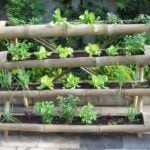Kitchen garden is also in need of our immediate attention. After all, their location, height, filling and shape depends not only on the yield of vegetable crops, but also the appearance of the site where we not only work but also relax. And we, of course, would like to see your suburban area well-groomed and beautiful.
Kitchen garden should be located from North to South: so the soil warms up better, and vegetable crops get more sun. If your site is located on a gentle slope, build beds across it, and if the slope is very steep, organize terraces (also across) and build boxes-beds there. So you can avoid leaching of soil by flood waters and rains.
Form kitchen garden
Form kitchen garden depends solely on your imagination! You can make them square, rectangular, round, in the form of a trapezoid, in the form of any objects, animals and so on.

And it is not necessary to build a kitchen garden of the correct form! You can arrange them, following the natural curves of the terrain, and the rejection of strict lines give not only aesthetic effect, but also will allow more use to dispose of garden ground.

Look how beautiful look kitchen garden unusual shape in landscape design!

The size of the kitchen garden
The sizes can be whatever you want, but you should easily reach the middle. And if you have built a kitchen garden close to the wall or fence, the distance estimate, based on whether you get your hands to the opposite side (usually the width of the wall kitchen garden does not exceed 80 cm). Standard size kitchen garden: 1 m wide, 1.5 m long and 30-50 cm deep.
Again, you can vary the size of their own-if only you were comfortable. The distance between the kitchen garden is usually 40-50 cm. This is enough to sit comfortably, caring for vegetable crops and harvesting. The paths should be 30-50 cm below the surface layer of the kitchen garden.
Features of the kitchen garden organization
You are free to equip the kitchen garden anywhere and in any way, but there are some features of the location that still should be considered.
Raised kitchen garden
To get an early and more abundant harvest (and just for beauty) it makes sense to make a raised kitchen garden.

To do this, you have chosen a place to dig a hole depth of 40 cm, and the selected land is set aside. The length of the pits choose randomly, but make the width of 1-1. 2 m, so that later you can care for plants. Around the perimeter of the pit install the frame from stones, bricks, sticks or other material to a height of 40-50 cm. Close it inside a polyethylene film, and on the bottom of the pit lay a grid of steel wire (this will protect the crop from harmful rodents).

The first layer fall asleep long decomposing organic material: trimming boards, chips, branches, paper, cardboard and so on. Fill these kitchen garden about 1/3, sprinkle a little bit with earth and pour a good layer of water. Next, fill the kitchen garden to the top with soil mixed with manure, compost, mineral fertilizers, and again pour water. That’s all the wisdom. Just keep in mind that the next year the land will settle on 15-20 cm and will need to update the top layer, so prepare fertile land in advance.

How to arrange kitchen garden on a small plot
If you have a small plot, and want to organize as much as possible kitchen garden, in addition to the usual location, use any horizontal surfaces and suspended structures.

It is possible to combine the recreation area with the decoratively decorated kitchen garden, using multi-tiered, spiral designs and other options.

When building a kitchen garden don’t forget that the surface must be strictly horizontal to prevent the accumulation of moisture in high and saturation is low.

Peculiarities of processing of soil on the kitchen garden
Land on the kitchen garden is usually dug twice (spring and autumn), making the necessary mineral and organic fertilizers. When digging in the fall it is better to leave the earth lumpy to keep on beds as much moisture as possible. In addition, with such digging larvae and eggs of soil pests almost completely freeze. You can replace the autumn digging mulching: cover the soil with a thick layer of peat, sawdust, decomposed compost, and other things. Spring is not decomposed layer is removed with a rake and dig the ground. Digging on the bayonet shovels for beds with vegetables or flowers is enough. And if the soil on your site is light and crumbly, spring digging can be replaced by loosening.
How to make beautiful bumpers for kitchen garden
Of course, not everyone is worried about the beautiful design of the bumpers for kitchen garden. Many people use the separation path, some just hit the Board square or perimeter, install these structures on a horizontal surface. But we want to make it nice, don’t we? Therefore, I present to you a few photos, which clearly shows how you can beautifully decorate the sides of the kitchen garden with a simple improvised or purchased material.






















